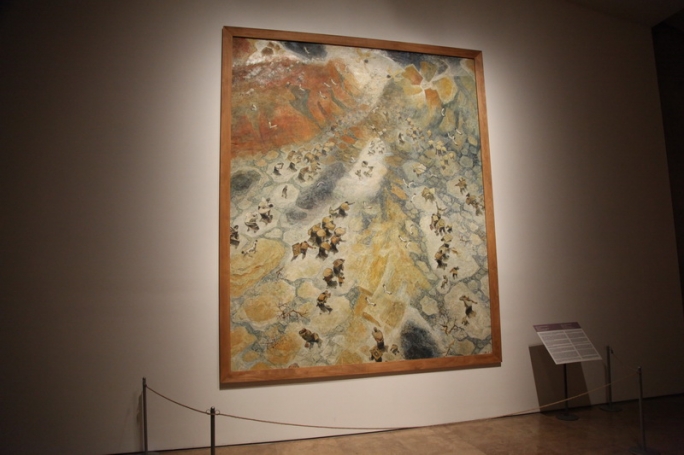
Khanjyan Gallery

A Solo Artwork: Migration
May 16, 2015 – June 21, 2015

In the artistic heritage of
Suren Pipoyan (1922-2005), an Honored Artist of Armenia, large-scale narrative paintings have a significant influence. Among those is the work Migration; about the Armenian Genocide, which became a central focus of the artist’s life.
This subject occupied the artist’s mind for 15 years. He began working on the first painting in January of 1965. As he wrote in his diary, “I read and study information about the Armenian massacres; the exhibition should be inaugurated in spring.” Elsewhere, he wrote: “Thus, I worked on Migration for 25 days; it was a period of intense creativity, I worked very hard. The composition was made of 100 figures; I had to paint all of them one by one. I completed the work in a very strong style, within a conventional environment and symbolically. At the exhibition, the work received unanimous approval, having a shocking impact on some people.”
The first example (140x122 cm) was executed with an almost monochrome, restrained dark brown-blue palette, typical of the artist for that period, in his unique cubist-expressionist style, by presenting endless columns of people sprawling by the sloping surface of a bare, harsh desert (perhaps mountains). Although they move from darkness to light, the general mood of the picture is tragic, painful. The small outline of the St. Hripsime Church is seen in the distance. The painting was called Road of Salvation.
In 1967 Suren Pipoyan made a copy of the painting in a larger size, 200x160 cm. This work was called Toward a New Armenia, in line with the ideology of Soviet Armenia.
In 1979 Pipoyan decided to address the subject once again, basically maintaining the same composition, but giving it a completely new interpretation and style of execution. First and foremost, the size of the painting was much larger than the previous one, 375x300 cm. The color scheme was also changed: from dark brown to gold-yellow, white, and blue-gray. An important detail was added; the refugees are received by angels. During work on the canvas, the artist studied Armenian national costumes.
The Armenians, forcefully evicted from their homes, march through a yellow desert, carrying precious relics such as books, icons, cross-stones, while holding a child, or a sick relative. Among them, one can discover the image of Komitas. The children and people seem to be taken by the wind; they resist somehow, but keep going. The birds scream. The migrants go straight into the embrace of angels. They go to heaven, or a new Armenia. The outline of St. Hripsime Church is seen in the distance. The painting is tragic and life asserting at the same time, with its golden coloring and pulsing rhythm. This is one of those rare paintings on the Armenian Genocide that confirms the faithfulness of the Armenian people to their culture and their enormous energy to thrive.
The work was exhibited at the Artists’ Union of Armenia in 1980 and received the Best Artwork of the Year award. Later, for many years, it was exhibited at the conference hall of the Museum-Institute of the Armenian Genocide. It is currently the property of the artist’s family.